Elliott

An advert from 1884.

Courtesy of Jim Boulton.
|

An Elliott machine from 1884. |
I. Elliott ran the Bicycle and Tricycle Exchange in
Victoria Street, Wolverhampton, from where he sold bicycles,
tricycles, and accessories of all kinds. |
Empire
The following is a short
description from "Bicycles & Tricycles of the Year 1889" by Harry Hewitt
Griffin:
The Empire Diamond Dwarf Safety Roadster. Perry,
Richards, and Co., Wolverhampton.
It will be seen at once by the illustration below that the well-shaped
diamond frame is neatly and effectively stayed by the tubular
seat-pillar curving to the shape of the wheel, uniting and strengthening
both the upper and lower frame tubes; the top forms a socket to receive
the plunger of the saddle-spring. In short, the arrangement makes a
really effective frame. The upper part of the pillar, above the top
frame, is generally cut off, and an Γ
-pin used, so that double adjustment may be given to the saddle. The
hollow front forks curve, and the steering pillar slants backwards, so
that the handles are in a convenient position; the brake is a direct
link-plunger. Special care is taken to make the real bearings dustproof,
with the result that the machine runs very easily. Both wheels (solid
rims, ¾in. tyres) are 30in.; a
permanent lamp bracket is fitted low down on the front forks, so that it
may be out of the rider's way. Bown's ball bearings are put to all
parts, and the machine is finished either plain black enamel, or lined
if preferred, and part plated. The net price is £13, cheap for the
excellent quality and neat finish.

The Empire Diamond Dwarf Safety Roadster.
|

An advert from 1893. |
The Empire No.2 Dwarf Safety Roadster.
A strong built,
single frame machine, with a novel means of chain adjustment. On the end
of each of the lower stays there is a ring boss going over the driving
wheel axle; the front ends of these rods are held below the
crank-bearing bracket, where, by the regulating nuts, the rear-wheel
axle is pushed out, and the chain tightened. Remainder of machine as per
usual. Price, balls all parts, etc., £12 net. |
Forder
 |
Frederick Forder the well known coachbuilder and
hansome cab maker of Cleveland Street built possibly a
considerable number of velocipedes in the late 1860s. They were
based on the heavy wooden wheeled Michaux design.
The machine in the photograph is being ridden by Alfred
Forder who achieved some success in the cycle races at the
Molineux Hotel grounds, in 1869. He won several races on his
Michaux style velocipede.
Photo courtesy of Jim Boulton. |
F. Gibbons - Cunard
Cycle Company
TI Magazine (the house magazine for Tube Investments)
for Nov-Dec 1968 carried an extensive article about James Gibbons Ltd.,
then a member of the TI group. Gibbons was one of the oldest and
biggest makers of locks and architectural ironmongery. It had
always been a family run firm and expanded greatly under the sixth
generation chairman, Francis Gibbons, who was with the firm from 1876 to
1946. The magazine reports of him:
| One of his earliest ventures was into 'velocipedes'.
At the same time as Frank Bowden was establishing the
fortunes of Raleigh at Nottingham, Francis Gibbons was
building penny-farthings at Wolverhampton and taking part in
a one-mile bicycle race at an athletics meeting at the
Molineux grounds. He must also have been one of the
first to be summoned for riding a bicycle without lights.
The summons of 1881, now framed, declares that 'Francis
Gibbons did unlawfully ride a bicycle between the hours of
one hour after sunset and one hour before sunrise, to wit
the hour of 45 minutes past nine at night without having
attached to your said bicycle a lap so constructed as to
exhibit a light in the direction in which you were
proceeding so lighted and kept as to afford adequate means
of signalling the approach of your said bicycle'. ... There
is no record of the penalty. |
The family firm of James Gibbons was not
incorporated until after the Second World War but when Francis
Gibbons decided to expand his bicycle making business he set up a
limited company for the purpose. This was undoubtedly to
insulate the family firm from the financial risk of what he was
clearly treating as a separate enterprise. He floated the
Cunard Cycle Company with a capital of £50,000 to take over his
bicycle and tricycle business. The date of this is not
recorded but Francis Gibbons was born in 1862 and said that he was
25 years old when he set up the company, giving a date of around
1887. He was able to claim that this was "the first registered
company for anything to do with bicycles". TI Magazine
continues:
| The prospectus declared his machines to be equal
to those of any other make and highly popular and it was
planned to step up production to 3,000 a year. The
venture was not a success and Mr. Gibbons notes, on a
share certificate for 500 shares in the company: 'This
company was formed when I was only 25 years old and I
was badly robbed by London thieves and after losing a
lot of money I sold the company to the Star,
Wolverhampton". |
This advert is from the
programme for the Wolverhampton Art
and Industry Exhibition
of 1884. |
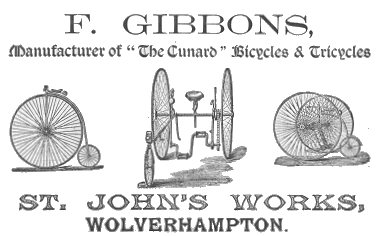 |
Gough Brothers
Joseph and Thomas Gough traded as Gough Brothers from
works that were located at the junction of Wolverhampton Street and
Wellington Road, Bilston. The company was formed in 1892 and closed in
1903. They produced a range of machines including the 'Midland Mail';
versions of which were available for both ladies and gentlemen. Joseph
Gough was born in 1868 and died in 1941. He was a prominent member of
the Bilston Bicycle Cub.
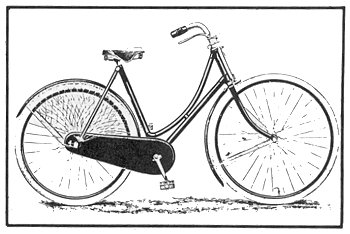 |
The 'Midland Mail' ladies
special. |
Griffiths

The following is a short
description from "Bicycles & Tricycles of the Year 1889" by Harry Hewitt
Griffin:
The Universal No.1 Dwarf Safety Roadster. S.
Griffiths and Sons, Clyde Works, Heath Town, Wolverhampton. A simple
type of machine, with single frame, well stayed fore and aft. There is a
ball-shaped boss at the top of the rear forks, through which the pillar
passes; the brake is a direct plunger, and the various usual details are
good, the list price, balls all parts, etc., being £14. There is also a
very neat lady's machine, "La Belle" at the same price.
The IXL Dwarf Safety Roadster. This is the latest introduction of
Messrs. Griffiths, and will, doubtless, be the most popular, being of
the favourite divided diamond pattern, having a strong central stay
between the crank bracket and the upper tube, 3in. before where it joins
the rear forks and supports the Γ
pin. The bracket is hinged, and can be drawn forward, by a set screw,
for adjustment. It also has a direct plunger brake and widely-curved
bars. The list price, balls all parts, etc., is £15, at which price
there is also a stronger type, the Irish IXL. There are, in addition,
several patterns of ordinaries, from £5 to £13.

IXL No.1 from 1891. Courtesy of Jim Boulton.

IXL No.2 from 1891. Courtesy of Jim Boulton.
 |
Clyde Works, Heath Town,
Griffith's premises. |
| The Griffiths Clyde No. 1 from
1891. |
 |
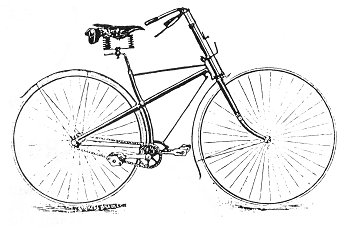 |
The Griffiths Clyde No. 2 from
1891. |
The following is a short
description of two of the company's tricycles from "Bicycles &
Tricycles of the Year 1889" by Harry Hewitt Griffin:
The Clyde Direct Steering Roadster. S. Griffiths
& Sons, Heath Town, Wolverhampton.
A 'V' shaped frame is connected with the steering pillar in front by
hinge steering centres, and by a four-bearing curved bridge, with
the axle at the back. The rear half of the connecting tube extends a
little beyond the front half, and, from an arm at the end, a set
screw regulates the chain adjustment; the chain itself is quite
covered in by a leather protector, and a curved guard shields the
dress from the lower chain pulley. All three wheels are 30in., and,
as ball bearings are fitted all round, the price of £18 is very low
indeed for so good a machine. The details include a direct plunger
brake.
The Universal Direct Steering Roadster. With the exception of
the connecting tube, the Universal is identical with the Clyde.
Instead of a 'V' frame there is a high, straight tube, or backbone,
with a seat-pillar, the lower part of the latter curved, forming a
cross frame. Stays run up to the front end of the backbone, and back
to the axle bridge. The price, etc., is identical with the
foregoing; £18. There is also an excellent Juvenile Universal, with
24in. driving wheels, at £6.10s.
 |
The photograph is believed to show
a Griffiths Clyde No. 2 bicycle.
Courtesy of the late Jim Boulton. |

The
Grosvenor Cycle Company, Wednesfield Road, in
1892, then Grosvenor Street in 1894.
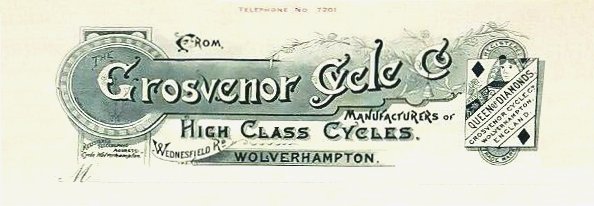
Gwinnett
The following description is
taken from "Sturmey's Indispensable Handbook to the Safety Bicycle,
Treating of Safety Bicycles, Their Varieties, Construction & Use" by
Henry Sturmey, published in 1885:
W. Gwinnett & Co., Melbourne Street,
Wolverhampton.
Description. ⅞in. and
¾in. red tyres. Crescent rims.
40 and 24 No. II direct spokes. Bown's G.M. hubs. Cranks, 6in.
throw. Rubber ball pedals, 12in. tread. 38in. driving wheel, geared
to 60in., 18in. back wheel. Front wheel drives with chain gear.
Aeolus ball bearings to crank wheels. Morgan's chains. Bolt and slot
adjustment. Ball bearings to both wheels. Steering like ordinary
bicycle. Forks pass 3in. behind bearings. Hollow front and
semi-hollow back forks. Stanley head, 4in. centres. Pear-shaped horn
handles, 28in. cow-horn bars. 1¼in.
16 W.G. steel backbone. Humber coil spring. Long-distance suspension
saddle. Saw-step. D.L.S. brake. Leg-guard. Spanners and oilcan.
Weight 42lbs. Price. £12. Sent out with plated handlebar,
head, hubs, cranks, etc., rest enamelled in colours.
Remarks. A machine on the usual general lines at a low
figure.
Hart
The following is a short
description of a Hart tricycle from "Bicycles & Tricycles of the
Year 1889" by Harry Hewitt Griffin:
The Hart Direct Steering Roadster. The Hart Cycle Company, Great
Brick-kiln Street, Wolverhampton. Built on the most popular lines,
there is little special to notice. The three wheels are of uniform
size-30in. Abingdon gear and axle bridge are used; the latter is a
straight tube, and the four ball bearings are clamped to it, instead
of being brazed, as is usually the case, so that they can be
detached if need be. The frame is 'V' shaped, rendering it suitable
to either lady or gentleman. Chain adjustment is effected by
screwing up the shank of a 'V' shaped holder, which draws forward
the bearing bracket. The brake is a lever plunger, the cranks are
detachable, and the other details are as usual, the whole making a
nice looking and cheap little machine at £18.10s.
The Hart Cycle Company later moved into a workshop in Darlington
Street, on the same side, and just below the Methodist Church, where
the car park is today. It was alongside one of the large yards which
were behind the shops.

Jack Hateley ran a cycle shop at 458 Stafford Road, Oxley.
He started selling cycles in 1942, and in 1945 began building
lightweight machines. He used the topical slogan "The Atomic Age Cycles"
and produced reasonable numbers of well made machines.
Jack was keen on competition work and started his own
racing team in 1947. They had many successes including the Birmingham
Premier Road Race, the first Tour of the Chase, "King of the Mountains"
tour of the East Midlands, "King of the Mountains" Brighton to Glasgow
and the Midlands Time Trial Championship. Successful team riders
included Harold Binfield.
| A revolutionary design was the Hateley
'Modic' that appeared in 1957. The small wheel cycle could
fit into the boot of a car and sold for £22.10s. A version
was also available with 3 or 5 speed gears and cost an extra
£2.12s.4d. |

The Hateley 'Modic'. |

|
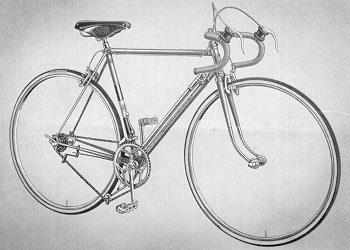
The Hateley Continental 'Praha'. Courtesy of
Jim Boulton. |
The Hateley Continental 'Praha' had elaborate cut
away fretted Super Champion Lugs, Reynolds Double Butted
531 tubing, and double Rapid taper seat stays. All the
fittings were brazed on to the frame, and the finish and
lining could be done to the user's specification. The
cost of the cycle, less the chain set was £12.15s.0d.
The machine had 27" wheels with San Georgia Sprint rims
and Solite Steel or Gnutti double sided hubs. Chrome
plating was available at extra cost. |
| The 'Warszawa', designed for the club man had 26 or
27 inch wheels, a Williams chain set, Perry or Reynolds
chain and Phillip's 'Apollo' pedals. The saddle was made
by Brooks or Wilby and the machine was priced at
£23.10s. Finishes were available in any colour and
included the special Hateley lining. The hand-built
bronze welded frame was well balanced and streamlined,
and available separately for £10.00. |

The Hateley 'Warszawa'. Courtesy of Jim
Boulton. |
|
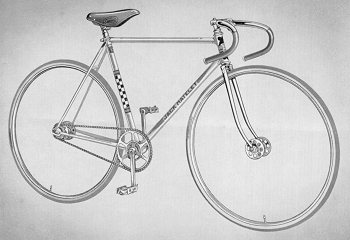
The Hateley 'Pavorit'. Courtesy of Jim
Boulton. |
The 'Pavorit' super track cycle had a 20 to 24inch
frame built from Reynolds 531 double butted tube.
Weinmans, Record or Scherens 27inch wheels were
available and a Williams C34 chain set was included. A
narrow or Sprinter Brooks B17 saddle could be fitted and
a choice of handlebars was offered. The machine sold
for £12.17s.6d., less the chain set. |
| The 'Wroglaw' designed for mass start and long
distance road events had a 21 to 25inch frame built from
Reynolds 531 double butted tube. The wheels were 26 or
27 inches in diameter and the 4 or 5 speed gearbox was
made by OS or Simplex. A Brooks B17 narrow or standard
saddle could be fitted and the pedals were Phillips
"Credulux" or Steel Quill pattern. The machine sold
for £12.10s. and the Gnutti 3 arm Continental chain set
was extra. |
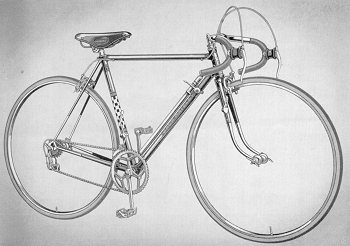
The Hateley 'Wroglaw'. Courtesy of Jim
Boulton. |
Hateleys also built the 'Atlanta' lightweight cycle
for young clubman that sold for £19.18s.6d. Cycle production ended
in 1983 when Jack died. After Jack's death his daughter Maureen
continued to run the cycle shop.
Highmoor

|
From an 1897 trade directory:
The Highmoor Cycle Co., manufacturers of high-grade cycles, in Church
Street.
One of the most prosperous of the
recently-established concerns in connection with the cycle manufacturing
industry in Wolverhampton, is that known as " The Highmoor Cycle
Co.," whose works, now in course of large extension, are situated in
Church Street. This business has rapidly assumed an important position
in the trade, a result that establishes convincing proof of the
first-class character of the cycles produced. In the works now being
erected, employment will be afforded for nearly 100 hands, and it is
evident that the Company intend to spare no expense in the equipment of
the same to ensure the very best manufacturing facilities. The gentlemen
at the head of affairs are Mr. S. T. Thomas and Mr. I. Elliott, and up
to now they have every reason to be proud of the
success that has attended their able and enterprising administration.
The Highmoor cycles for ladies and gentlemen combine all the latest
improvements, and are absolutely unsurpassed for speed, strength, light
running, and uniformly high-class workmanship and finish. This Company
aim to place only the most reliable " mounts " on the market, and to
this fact they undoubtedly owe their rapidly widening connection.
Repairs are speedily executed,. and all the latest pattern component
parts are supplied at lowest prices. There is no doubt that the "
Highmoor " machines will continue to advance in popularity amongst all
riders who value quality before cheapness, hence we can safely predict a
large expansion of trade for a business so ably and enterprisingly
conducted. |
|



